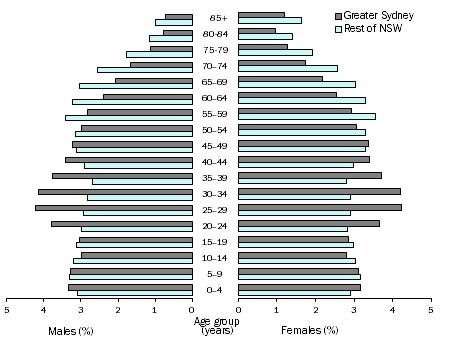NEW SOUTH WALES
MEDIAN AGE
- At June 2017, the median age (the age at which half the population is older and half is younger) of the New South Wales (NSW) population was 37.5 years, down from 37.7 at June 2012. The median age of males in 2017 was 36.6 years compared with 38.4 years for females.
- In the five years to 2017, the median age in Greater Sydney decreased from 36.1 to 35.8 years, and increased from 41.2 to 42.1 years in the rest of NSW.
- The SA2s with the highest median ages were located in regional areas on or near the coast. These included Tea Gardens - Hawks Nest (62.4 years) near Port Stephens, Tuncurry (60.8) on the Mid North Coast, and Sussex Inlet - Berrara (58.9) on the south coast.
- The SA2s with the lowest median ages included Kensington (25.9 years), which contains the University of NSW, and neighbouring Kingsford (26.8). A number of major regional centres such as Shortland - Jesmond (26.1) in Newcastle, Wagga Wagga - North (28.8) and Tamworth - West (29.6) also had comparatively low median ages. Many of these areas contain higher education campuses.
SA2s WITH OLDEST AND YOUNGEST MEDIAN AGES(a), New South Wales, 2017
|
|
 |  | Median Age |
| SA2 | GCCSA | years |
OLDEST MEDIAN AGES |
|
| Tea Gardens - Hawks Nest | Rest of NSW | 62.4 |
| Tuncurry | Rest of NSW | 60.8 |
| Sussex Inlet - Berrara | Rest of NSW | 58.9 |
| Narooma - Bermagui | Rest of NSW. | 57.7 |
| South West Rocks | Rest of NSW | 56.4 |
YOUNGEST MEDIAN AGES |
|
| Kensington | Greater Sydney | 25.9 |
| Shortland - Jesmond | Rest of NSW | 26.1 |
| Kingsford | Greater Sydney | 26.8 |
| Wagga Wagga - North | Rest of NSW | 28.8 |
| Tamworth - West | Rest of NSW | 29.6 |
|
| (a) Excludes SA2s with a population of less than 1,000 at June 2017. |
SEX RATIO
- At June 2017, there were 98.4 males for every 100 females in NSW. The sex ratio was slightly higher in Greater Sydney (98.7) than in the rest of NSW (97.8).
- The SA2 of Auburn - North in western Sydney had the highest sex ratio in NSW (140.5 males per 100 females) followed by Junee (135.8), which contains the Junee Correctional Centre. High sex ratios were also apparent in Darlinghurst (133.1), Surry Hills (132.1) and Potts Point - Woolloomooloo (130.4), all in inner Sydney.
- The lowest sex ratios were in Woollahra (83.4) in Sydney's east and Castle Hill - East (84.0) in Sydney's north-west.
SA2s WITH HIGHEST AND LOWEST SEX RATIOS(a), New South Wales, 2017
|
|
 |  | Sex Ratio |
| SA2 | GCCSA | males per 100 females |
HIGHEST SEX RATIOS |
|
| Auburn - North | Greater Sydney | 140.5 |
| Junee | Rest of NSW | 135.8 |
| Darlinghurst | Greater Sydney | 133.1 |
| Surry Hills | Greater Sydney | 132.1 |
| Potts Point - Woolloomooloo | Greater Sydney | 130.4 |
LOWEST SEX RATIOS |
|
| Woollahra | Greater Sydney | 83.4 |
| Castle Hill - East | Greater Sydney | 84.0 |
| Tweed Heads South | Rest of NSW | 86.1 |
| Mittagong | Rest of NSW | 86.7 |
| Coffs Harbour - South | Rest of NSW | 87.0 |
|
| (a) Excludes SA2s with a population of less than 1,000 at June 2017. |
AGE AND SEX DISTRIBUTION
- The age distribution of Greater Sydney was younger than for the rest of the state. At June 2017, 32% of Greater Sydney's population were aged 20 to 39 years, compared with 23% in the rest of the state. Conversely, in the rest of NSW, 27% of the population were aged 60 years or over, compared with 19% of the population in Greater Sydney.
AGE AND SEX DISTRIBUTION (%), New South Wales - 30 June 2017

 Quality Declaration
Quality Declaration  Print Page
Print Page
 Print All
Print All